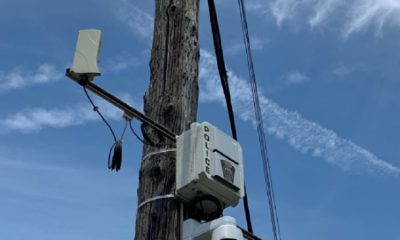Local News
Using this map of Monroe County, you may find the location of a gas that causes cancer

Monroe County, Indiana – Radon is a radioactive gas that is released when naturally occurring uranium in rocks and soil breaks down at a deep depth of the earth. It rises through the soil and disappears into the atmosphere. However, when radon leaks beneath a house or other structure, it enters through the smallest gaps and fissures in the foundation and soon builds up inside the building, where it becomes trapped.
From there, locals may inadvertently breathe in the odorless and colorless gas. The lining of the lungs is harmed by energy bursts released by the particles as they continue to disintegrate. The damage can accumulate over time to the point where cancer can develop.
Living in Indiana and much of the United States has always come with an inherent danger of radon, but knowledge is growing. The ubiquitous prevalence of the gas and the need for testing were emphasized once again this year when the Monroe County Health Department created an interactive map that clearly depicted its existence.
There are other places besides dwellings in Bloomington where radon contamination exists. According to the Environmental Protection Agency, nearly one in three homes tested in Indiana had dangerously high levels of radon—four picocuries per liter or higher—but the gas also affects individuals nationwide.
The main cause of lung cancer in nonsmokers is prolonged exposure to the gas; smokers’ chances of developing lung cancer might also be raised by inhaling radon.
Although the map was only posted this year, Simeon Baker, a senior environmental health specialist at the MCHD, stated that the testing that provide the data for the map started in the 1980s. The main lesson, in Baker’s opinion, is that radon is present everywhere; the question is simply how much.
According to Baker, variations in wind speed, seismic activity, and moisture content can all have an impact on radon levels. Radon levels can frequently differ significantly within a neighborhood.
Given that levels might fluctuate over time, the state advises residents to test their houses annually. Although the county provides free online tests, in order to order one, you have to be a homeowner. In Bloomington, renters have two options: they can buy a radon test or ask their landlord to do one, but they will need their landlord’s approval before doing any mitigation.
Director of Bloomington Housing and Neighborhood Development Anna Killion-Hanson stated that landlords are not required to take action if a tenant discovers high levels of radon in a house.
Additionally, they are not required to tell prospective tenants about the gas.
“There really are no tenant rights in regards to the radon,” she said.
The price of radon mitigation, which entails drawing the gas from the earth and releasing it outside the house, is far higher than that of at-home testing, which may run as low as $10. According to Killion-Hanson, multifamily homes typically face greater difficulties and costs, which may act as an additional deterrent for landlords.
According to James Plessinger, who offers radon mitigation through his business Bloom Enviromental, the typical cost of mitigation is between $1,500 and $2,000.
Although Plessinger usually observes values between 7 and 10 pCi/L, he has observed levels exceeding 100 on Bloomington’s northwest side. As radon tends to be higher in limestone rock formations than other types, he thinks this is because of the close proximity to limestone quarries.
A mere 4 pCi/L of radon is the same as eight cigarettes a day, whereas 100 pCi/L of radon is the same as 200 cigarettes a day when inhaled.
Plessinger has also personally witnessed the differences in levels between residences. He remembered that a neighbor 40 yards away had 4 pCi/L and one house had levels of roughly 50 pCi/L.
Plessinger has observed an increase in awareness of the issue over the last five or six years; calls that were formerly made once a month have now multiplied to several each day.
“Everyone in Monroe County should be aware of it,” he said. “Most houses are likely elevated.”
-

 Local News2 weeks ago
Local News2 weeks ago3 Indiana school districts asking voters for funding in May primary election
-

 Local News2 weeks ago
Local News2 weeks agoHendricks Co. Sheriff’s deputy dies after being electrocuted at crash scene
-

 Local News2 weeks ago
Local News2 weeks agoMyles Rice, a former Pac-12 Freshman of the Year, has committed to Indiana
-

 Local News1 week ago
Local News1 week agoMan who won the primary election despite being accused of murder was found guilty of a lesser crime
-

 Local News2 weeks ago
Local News2 weeks agoIndiana limits abortion data for privacy under near-total ban; some GOP candidates push back
-

 Local News2 weeks ago
Local News2 weeks agoRepresentative from Indiana invites people to attend the IBLC town hall series
-

 Local News2 weeks ago
Local News2 weeks agoA decrease in gun violence signifies South Bend’s accomplishment
-

 Local News2 weeks ago
Local News2 weeks agoWhile searchers continue to look for missing kayakers, experts warn of a deadly dam in the White River






Leave a Reply